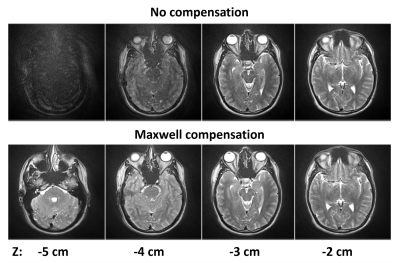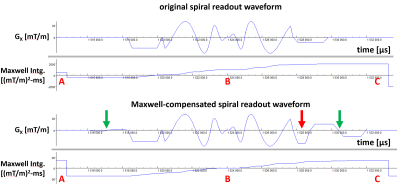John P. Mugler1, Adrienne E. Campbell-Washburn2, Rajiv Ramasawmy2, Josef Pfeuffer3, and Craig H. Meyer1
1University of Virginia, Charlottesville, VA, United States, 2Cardiovascular Branch, Division of Intramural Research, National Heart, Lung, and Blood Institute, National Institutes of Health, Bethesda, MD, United States, 3Siemens Healthcare GmbH, Erlangen, Germany
1University of Virginia, Charlottesville, VA, United States, 2Cardiovascular Branch, Division of Intramural Research, National Heart, Lung, and Blood Institute, National Institutes of Health, Bethesda, MD, United States, 3Siemens Healthcare GmbH, Erlangen, Germany
An
interleaved-spiral T2-weighted
2D-TSE sequence was developed that incorporates gradient waveform modifications
to achieve compensation of self-squared Maxwell terms at both the echoes and
over echo spacings. This approach provided
substantial improvement in image quality at 0.55T.

Figure
4.
Axial spiral-in-out images of a healthy volunteer without (top row) and
with (bottom row) Maxwell compensation, acquired at 0.55T. Substantial artifacts seen without compensation
are suppressed with compensation.
Parameters included: TR/TEeff: 3200/~130 ms,
FOV: 250 mm, slice thickness: 5 mm, slices: 11, matrix: 320, interleaves: 90,
trajectory: self-retraced 7.2-ms spiral in-out, averages: 4 with T2-decay
compensation (8 total), Maxwell compensation: 4.4 ms
per echo spacing, acquisition time: 2.6 min.

Figure
2. Self-retraced spiral in-out
waveform and associated Maxwell integrals illustrating compensation achieved by
adapting trapezoidal waveforms (red arrow) and adding bipolar waveforms (green
arrows). Without compensation, Maxwell
integrals at times A and C are not equal and that at B is not zero, whereas
values at A and C are equal and that at B is zero with compensation. A small
bipolar is sometimes needed because gradient duration is a discrete variable,
and so the exact change in Maxwell integral required is not achieved by only
modifying the trapezoidal waveform.
